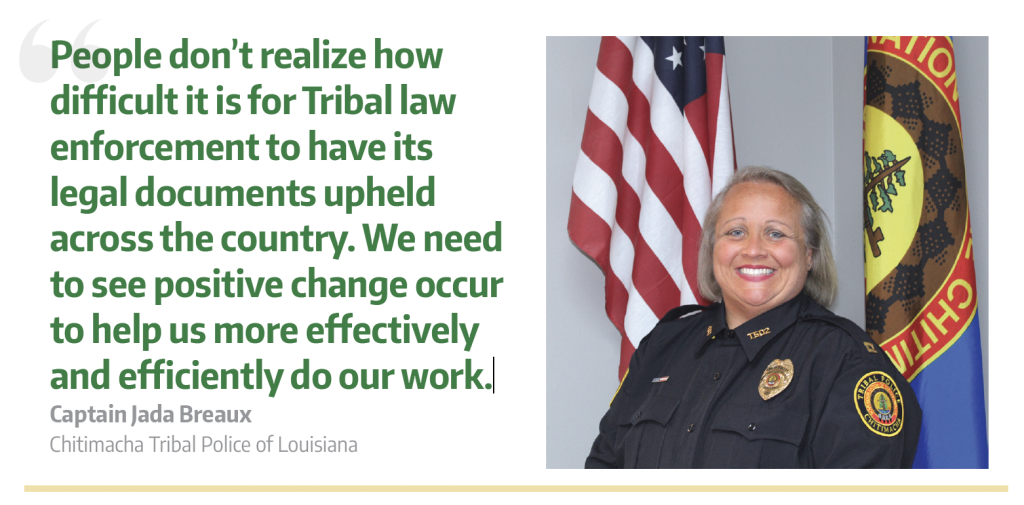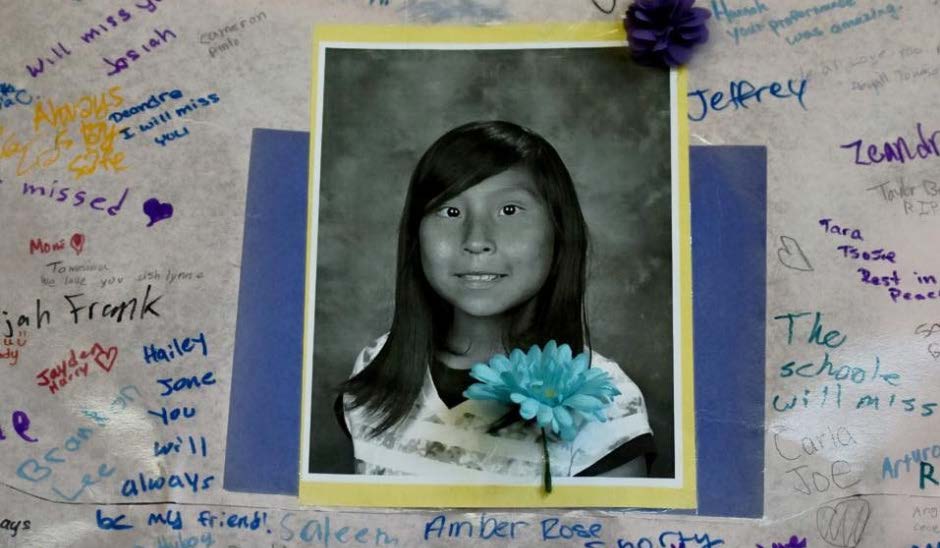
By Rebecca Sherman
As the new Captain of the Chitimacha Tribal Police Department in south Louisiana, Jada Breaux’s days are often packed with administrative duties and supervisory obligations.
The work she’s most passionate about, however, is looking out for all those she calls “my children” on the Chitimacha Reservation. It gets her out from behind her desk to work with youth as an instructor for the D.A.R.E (Drug Abuse Resistance Education) program.
This passion also keeps her training for any missing child case she may have to handle— and sometimes requires giving law enforcement colleagues in surrounding parishes a crash course in two words that tend to stop people in their tracks— “sovereignty” and “jurisdiction.”
“Many think Tribal sovereignty means working with outside law enforcement is not welcomed or encouraged. But even though we’re on sovereign land, we function just like everyone else—and know working with our regional and state colleagues is crucial,” Breaux says.
Confusion over the Tribe’s authority to issue AMBER Alerts or subpoena critical information can create life-threatening delays. Thankfully Breaux has a good working relationship with the St. Mary Parish Sheriff’s Office, which can help her with such needs. But neither the Chitimacha, nor the state’s three other federally recognized Tribes, have Memorandums of Understanding (MOUs) in place to seamlessly engage with state law enforcement when time is of the essence—particularly when searching for Tribal missing children. Breaux aims to change that. “Without collaboration, nothing can be accomplished,” she says. We spoke more with her shortly after seeing her at the 2023 AMBER Alert Training and Technical Assistance Program (AATTAP) and AMBER Alert in Indian Country (AIIC) Symposium in Arizona.
 What challenges are unique to your job?
What challenges are unique to your job?
I started my law enforcement career at the Iberia Parish Sheriff’s Office before making the move to the Chitimacha Tribal Police Department 17 years ago. It was an entirely new world for me. One of the most unique challenges is understanding jurisdiction. You have to learn where [oversight] falls— be it Tribal, state, or federal. Currently Louisiana’s Tribes do not have active MOUs allowing us to directly initiate AMBER Alerts or request search warrants. And while I respect the system, it can be frustrating. For instance, in investigating one juvenile case, I submitted a search warrant to a social media company, and they replied that they were not able to honor it because they don’t recognize the Chitimacha Tribal Court as a legal entity. Before having to go through all the extra steps needed to issue that warrant, we fortunately were able to locate the child; but the situation was eye-opening. It would have cost us a lot of extra time, which is not on our side when children are missing. I would like to see this change.

What are some of the initiatives you’re working on to foster understanding?
One of the biggest challenges is the lack of awareness about Indian Country. I’m a firm believer in knowledge and education, so I’m working with AATTAP/AIIC Program Manager Tyesha Wood and Project Coordinator Valerie Bribiescas to bring training here this fall. We plan to invite all the Tribes in Louisiana and the law enforcement agencies with whom we work. We also want to host trainings on Missing or Murdered Indigenous Persons (MMIP) investigations. We need to strengthen and sustain our public safety partnerships.
What motivates you to go into work? One of my motivations is the community I serve. While I’m not a member of the Tribe—my father’s mother was a member of the Choctaw Nation—everyone here has embraced me as one of their own. I have attended countless weddings and graduations, and watched a whole group of children become young adults and succeed as they chase their dreams. I’d like to think that I’ve had a small hand in that from being their D.A.R.E. instructor, or just the officer who hung out with them at school. I’ve had former students thank me years later for helping them make difficult choices by using tools from the D.A.R.E. program. There’s nothing more rewarding than being able provide resources to our children and watch them not only become productive members of our Tribe, but also of our society.
Ashlynne Mike’s legacy:
A law to help Tribal children—and law enforcement

Chitimacha Tribal Police Captain Jada Breaux remembers the deep sense of loss she felt after hearing the news that Ashlynne Mike had been abducted and murdered on the Navajo Nation in 2016.
“But it was only after I heard Ashlynne’s mother, Pamela Foster, speak at the 17th annual National Indian Nations conference that I learned more about the heartbreaking story—and the jurisdictional confusion following Ashlynne’s abduction being reported.”
Like many Tribal leaders across the nation, Breaux realized that if communication weaknesses and jurisdictional misunderstandings could happen to the nation’s largest Tribe (spanning three states and 27,000 square miles) what did that portend for the 573 other federally recognized Tribes, which have much significantly fewer resources?
Born from this tragedy was the Ashlynne Mike AMBER Alert in Indian Country Act of 2018, created to foster greater collaboration between Tribes and their state and local law enforcement counterparts, and to strengthen resources. To accomplish this, the U.S. Department of Justice’s AMBER Alert in Indian Country initiative helps Tribes learn what the law entails, and provides numerous no-cost resources, from training events to Technology Toolkits (“which we’ve already put to good use,” Breaux says).
“At the end of the day, everyone in law enforcement should have the same goal: to find a missing child as quickly as possible, using every available resource,” Breaux adds.
